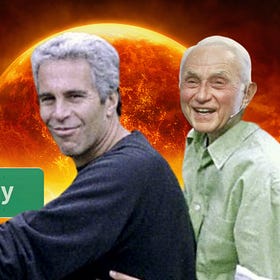Ted Carter’s ‘Wingman’: E. Gordon Gee and the Strauss Cover-Up
Ohio State has once again betrayed the survivors living with the trauma of Richard Strauss’ abuse.
The front page of Ohio State University’s website about the Richard Strauss scandal loudly proclaims:
“Ohio State is a fundamentally different university today than it was when Strauss was an employee.”
That line is OSU’s legal shield, its defense in court: don’t hold us liable, we’ve changed.
For a while, some people bought it.
Until August 21, when OSU President Ted Carter torched that narrative with one breathtaking announcement: Carter—a former fighter pilot who unironically insists on being called “Top Gun” —proudly proclaimed from the Columbus Metropolitan Club stage that he had brought back as his “wingman”—none other than former OSU president E. Gordon Gee, the man who oversaw Strauss’ quiet departure from the university.
The Columbus Dispatch wrote: “[Gee] is gonna be something of an adjunct professor, but also, as Gordon and I agreed to, he’s gonna be Ted Carter’s wingman," Carter said to laughter from the crowd. "So, we’re looking forward to having him.”
This is Gee’s third stint at Ohio State.
His second presidency is infamous not for growth or glory but for Gee’s central role in enabling one of the darkest scandals in American higher education.
The Independent Investigation
An independent investigation led by law firm Perkins Coie pulled no punches:
Dr. Richard H. Strauss sexually abused at least 177 male students at Ohio State between 1978 and 1998.
The abuse happened across athletics, student health services, and medical studies.
University personnel knew about Strauss’ misconduct as early as 1979 but failed to act meaningfully until 1996.
The failures were systemic, affecting reporting, oversight, policy enforcement, and even the management of facilities.
And who shows up again and again in the report? Dr. E. Gordon Gee.
Gee’s Name in the Report
Ted Carter’s new “wingman” appears 33 times in the independent investigation.
That’s not an accident.
It’s because Gee’s fingerprints are all over the way Ohio State handled Strauss.
The record is clear that President E. Gordon Gee was made aware of Strauss’ misconduct in 1997, when Strauss personally appealed to him after being removed from his clinical roles.
Gee acknowledged being briefed by university lawyers and senior administrators about the allegations and Strauss’ disciplinary record. By October of that year, Strauss was told directly that President Gee would take no further action on his case (Perkins Coie Report, pp. 164–165).
Gee allowed Strauss to quietly retire in March 1998.
Despite the serious complaints and the disciplinary action that had already ended his medical practice at Ohio State, Gee oversaw Strauss being awarded faculty emeritus status.
That recommendation originated from the School of Public Health and progressed through the university’s academic process, with administrators, including Gee, being aware of the misconduct (Perkins Coie Report, pp. 154–155).
The emeritus title conferred prestige and legitimacy, allowing Strauss to exit the university quietly and without public scrutiny.
After leaving Ohio State, Strauss opened an off-campus men’s clinic in Columbus. There, he continued to treat—and to abuse—patients, including Ohio State students (Perkins Coie Report, pp. 82–87).
The emeritus distinction and the university’s silence helped provide him with cover as he carried on the very same pattern of sexual misconduct outside the university’s walls.
A 'Fundamentally Different University'?
Ohio State, as it fights against Strauss’ survivors in court, would like you to believe this was all long ago. That Strauss’ crimes belong to a different era.
But how “different” can the university be if it just rehired the man who engineered Strauss’ soft landing?
The report is clear: Ohio State leaders had the chance to act, and they didn’t. They prioritized protecting the institution’s reputation over protecting students. And E. Gordon Gee was central to that calculus.
Why It Matters Today
Ted Carter could have chosen anyone as his “wingman.” He chose Gordon Gee. That’s not just tone-deaf—it’s a betrayal of survivors who still live with the trauma of Strauss’ abuse.
Every time the university insists it’s 'fundamentally different,' survivors can now point to Gee’s office on campus and say: Really?
The Strauss report mentions Gordon Gee 33 times. Each mention is a reminder that the cover-up wasn’t incidental. It was administrative policy. It was a betrayal of Buckeye values. It was an abject failure of leadership. And today, that leadership is back at the table.
Time and change? It’s been some time, but Ted Carter can no longer claim anything has changed.
Not so long as Gee is his “wingman”.
The Rooster’s Ohio State dossier

Ohio State Board of Trustees chairman John W. Zeiger is the personal lawyer to Central Ohio billionaire Leslie Wexner.
In many ways, Wexner has shaped the local land-grant university in his image.
Here are recent dispatches about the many (often evil) ways that play out:
Weak men create hard times
The current trouble for Ohio State’s football program can be traced to university trustees failing to fire Urban Meyer like a dog in 2018.
Why is Jeff Epstein's best friend still calling shots in Columbus?
Despite our steady population growth, Columbus will never be a true Big City until two things happen:
"Surviving Ohio State" should end Jim Jordan's political career
Surviving Ohio State, the documentary about the Dr. Richard Strauss sexual abuse scandal that debuted on HBO last night, would end Congressman Jim Jordan’s political career in a functioning society.
Ross Bjork is the future of Ohio State football
A nice perk about living in Ohio is that you can expect the worst at all times, in everything, and more often than not, be right:









OSU's very own Jerry Sandusky
Thank you for continuing to spotlight Wexner. He is connected to everything vile and creepy including the bizarre failure of his hospital to protect Healthcare providers from violence. Nurses know.